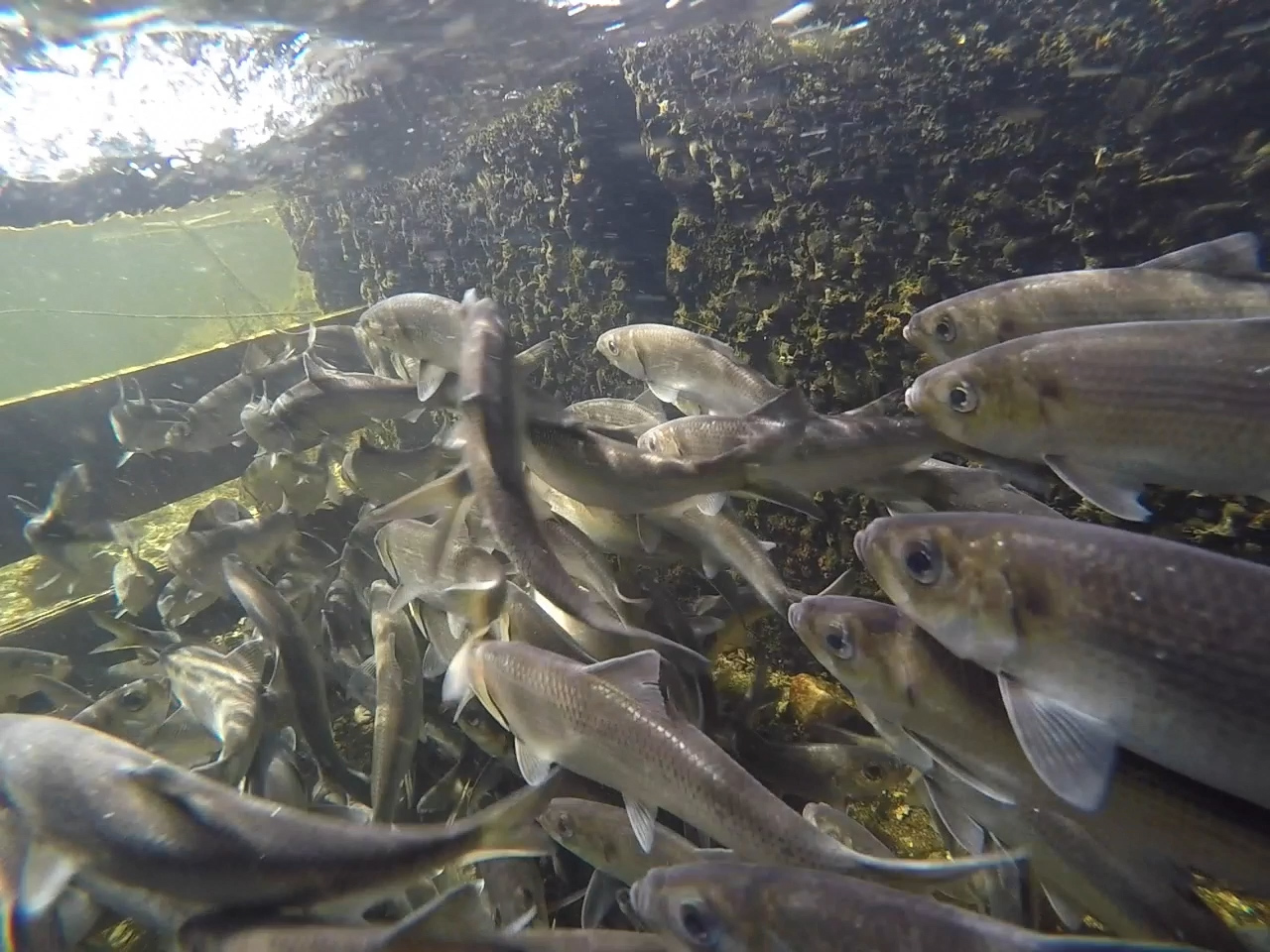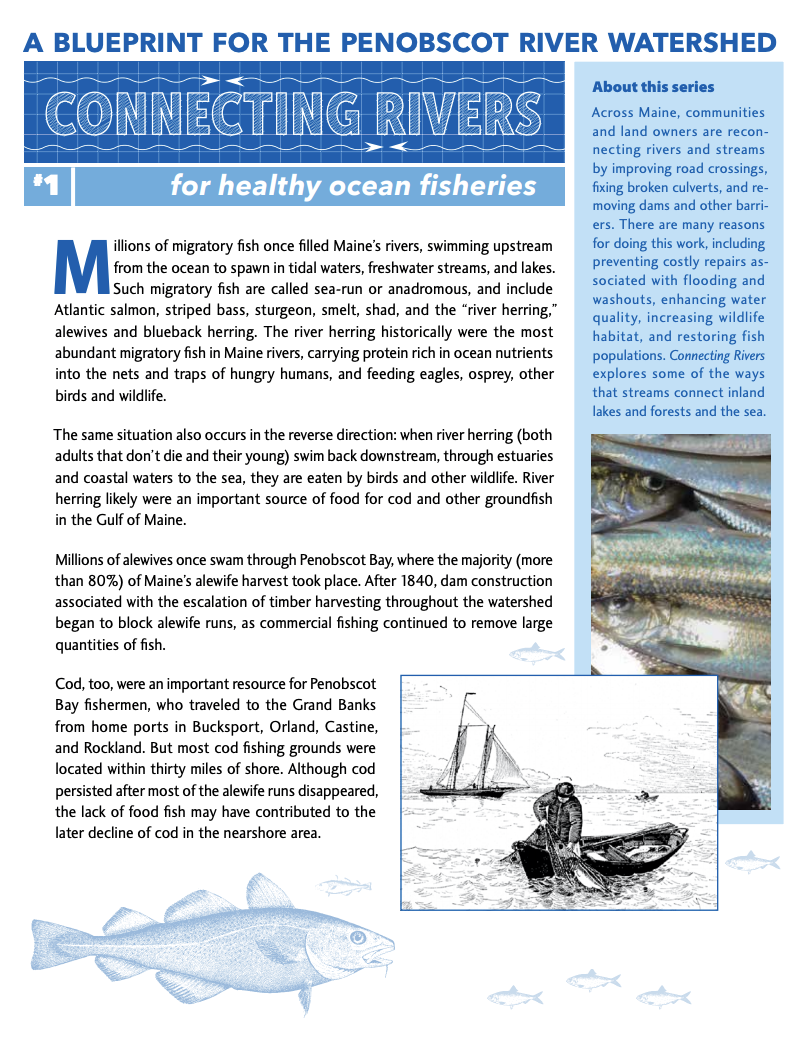Sea-run Fish
 What are sea run fish?
What are sea run fish?
Sea-run fish are those species that spend a portion of their lives in freshwater and a portion of their lives in the ocean. Usually, this means a significant migration once or twice in their lifetime to complete their life cycle. They have adapted to this life history because each habitat offers different advantages for growth and survival. In general, freshwater habitats have fewer predators, while the ocean offers a wider array of food choices.
Learn more about sea-run fish.
Why are sea run fish important?

Sea-run fish transport nutrients to and from habitats during their migration, creating a nutrient conveyor belt that makes energy and resources available to different parts of the food web in different ecosystems.
For thousands of years, sea-run fish provided a rich protein source and sustenance for the Wabanki people. The practice of harvesting sea-run fish was adopted by European colonialists and continued through the industrial revolution. Today, some species are still harvested for food and continue to be celebrated by communities throughout Maine.
What problems do they face?
During their migration, some sea-run fish are found in large, dense schools that can be exploited by predators, including humans. Obstacles, such as dams, can delay or block their migration pathways and prevent the fish from completing their life cycle. Since the industrial revolution, sea-run fish have faced reduction in available habitat due to dams, impacts from pollution degrading habitat, and overfishing, all leading to severe declines in their populations. Recently, efforts are underway throughout Maine to improve water quality, remove dams, and improve passage at existing dams. Maine Sea Grant and our partners are working to engage communities to:
-
- Understand the value of ecosystem services provided by connected coastal watersheds and robust populations of native sea-run fishes
- Understand the value of native sea-run fish populations as forage in the Gulf of Maine
- Understand the effects of human activities (including restoration efforts) and environmental changes on coastal watershed resources.
- Increase scientific understanding of ecosystem-level effects of habitat restoration on marine-coastal food webs and water quality.
Research
Maine Sea Grant Sea-run Fish Research Program
The NOAA-Fisheries and Maine Sea Grant Partnership leverages the strengths of both organizations to improve data systems across agencies and the University of Maine while fostering new synergistic relationships and better communication among state, tribal, federal, and stakeholder groups.
Maine Sea Grant is working to build a fish and habitat assessment program that leverages NOAA, Maine Department of Marine Resources, and University of Maine data and systems across the Penobscot River and Bay Watershed. An overarching goal of the program is to build capacity in Maine by sharing existing information and bringing together those people who support sea-run fish research. This would be accomplished through collaboration with the University of Maine; Maine Department of Marine Resources; non-government conservation organizations; other federal partners, including US Fish and Wildlife Service, US Geological Survey, and US Department of Agriculture; and interested stakeholder groups; and interested stakeholder groups.
Maine Sea Grant-Funded Research
- DV-18-02 Bagaduce Estuary fish population surveys
- DV-17-22 Bagaduce Watershed Monitoring
- DV-17-08 Testing the effectiveness of eel life cycle study methods in Downeast Maine
- DV-17-04 A comparison of farmed versus wild American eel products
- R-16-04 Improving assessment of critical habitat for Atlantic salmon in a rapidly changing climate
- DV-16-26 Assessing possible mercury contamination in juvenile river herring in the Penobscot Estuary
- DV-13-04 Downeast Smelt Fry
- R-14-04 Variation in Habitat Use by Juvenile River Herring
- DV-12-11 Downeast Smelt Fry
- R-12-13 The role of wild and farmed fish in modulating the infectious pressure of the sea louse
- DV-10-22 Jump starting an ecosystem: reintroduction of forage fish to North Haven
- DV-10-11 Sedgeunkedunk Stream Symposium & Celebration
- R-10-03 Restoration of anadromous fishes: the effects of dam removal and habitat conditioning in spawning streams
- DV-09-007 Movin’ on up after dam removal: the effects of sea lamprey spawning in Atlantic salmon nursery streams
- DV-07-004 Spring Running Festival
- DV-06-008 Characterizing brook trout movement in coastal waters
- DV-08-003 Striped bass movement in the lower Penobscot: Do they stay or do they go?
Extension
Maine Sea Grant extension associates have worked with Maine coastal communities on the following projects:
Marine Extension Associate Chris Bartlett has worked with three townships and partners to monitor river herring.
- Pembroke – Since 2012, Bartlett has worked with the Department of Marine Resources and the Town of Pembroke to monitor spawning populations of river herring in the Pennamaquan River with hopes of re-establishing commercial harvest. Bartlett has collected biological samples since 2012, participated in a fish counting program since 2014, and contributed to education and outreach efforts with schools and community members since 2013. Population estimates have increased from 72K to 360K from 2014 – 2019. Other partners that have joined the effort include Downeast Salmon Federation and the Passamaquoddy Tribe. Read more about this decade-long restoration effort.
- Perry – Bartlett is working with the Department of Marine Resources and the Town of Perry to manage existing commercial harvest. He has been collecting biological samples since 2008, and he participated in a fish counting program for one year in 2018.
- Meddybemps – Bartlett works with the Department of Marine Resources and the Town of Meddybemps to monitor the spawning population in Dennys River with hopes of re-establishing commercial harvest. They installed an electronic resistivity counter in 2019.
Smelt surveys – Marine Extension Associates Justin Stevens and Chris Bartlett have helped to collect data for a research effort led by Downeast Salmon Federation, The Nature Conservancy, and the Department of Marine Resources.
Education
Maine Sea Grant is partnering with NOAA’s Northeast Fisheries Science Center (NEFSC) to provide opportunities for undergraduates to gain experience in the field of fisheries. In the summer of 2020, the partnership launched its Undergraduate Internships in Sea-run Fish Research.
- Read about the 2020 interns
- Read about the 2021 interns
- Read about the 2022 interns
- Read about the 2023 interns
- Read about the 2024 interns
Marine extension team members have also engaged in informal education programs for sea-run fish with primary, secondary, and post-secondary schools. Our goal is to help students understand the ecological value of connected coastal watersheds and robust populations of native sea-run fish. This understanding is critical to developing environmental literacy and inspiring future generations of sea-run fish stewards.
Staff
Chris Bartlett
Natalie Springuel
Justin Stevens
Gayle Zydlewski
